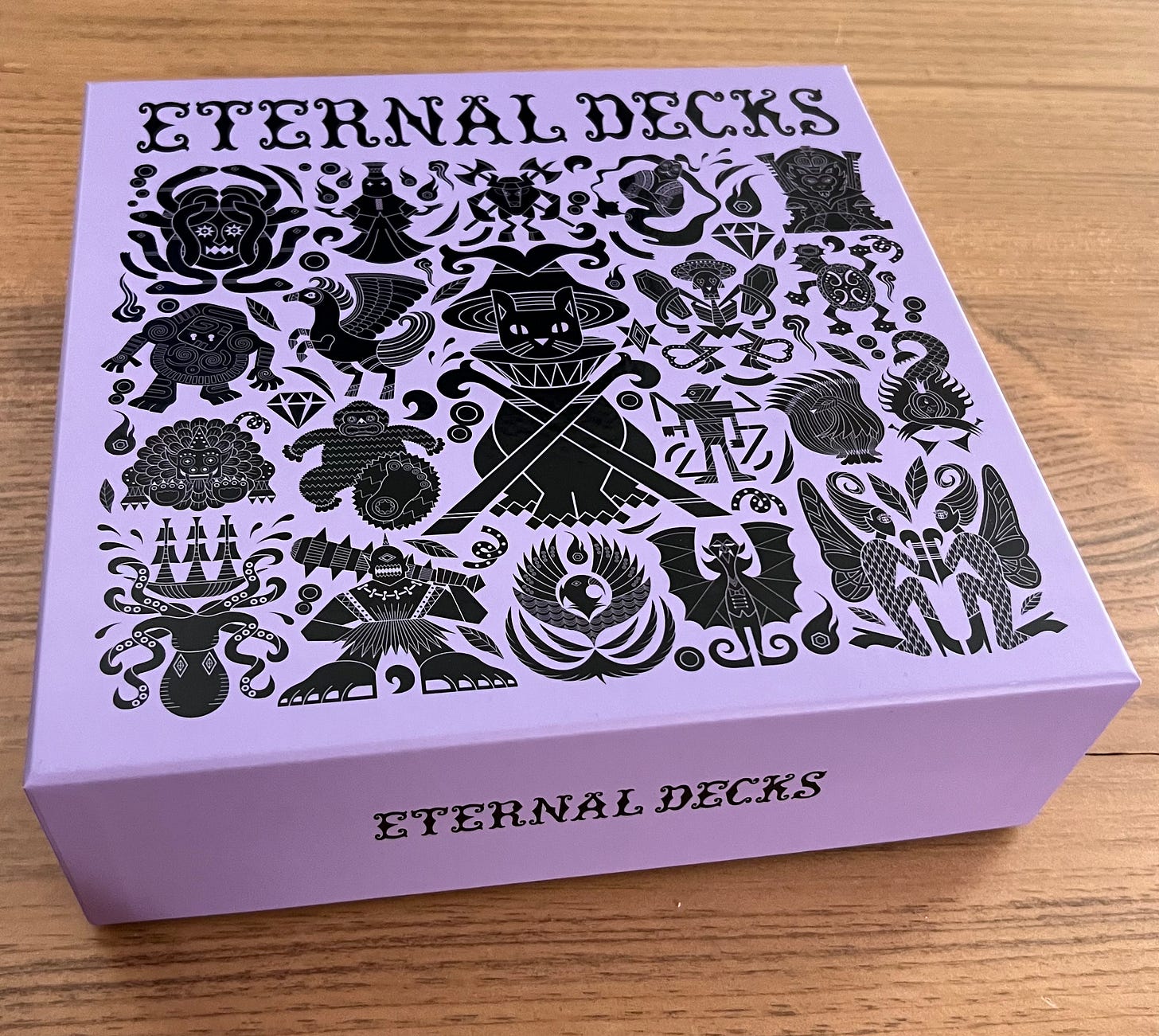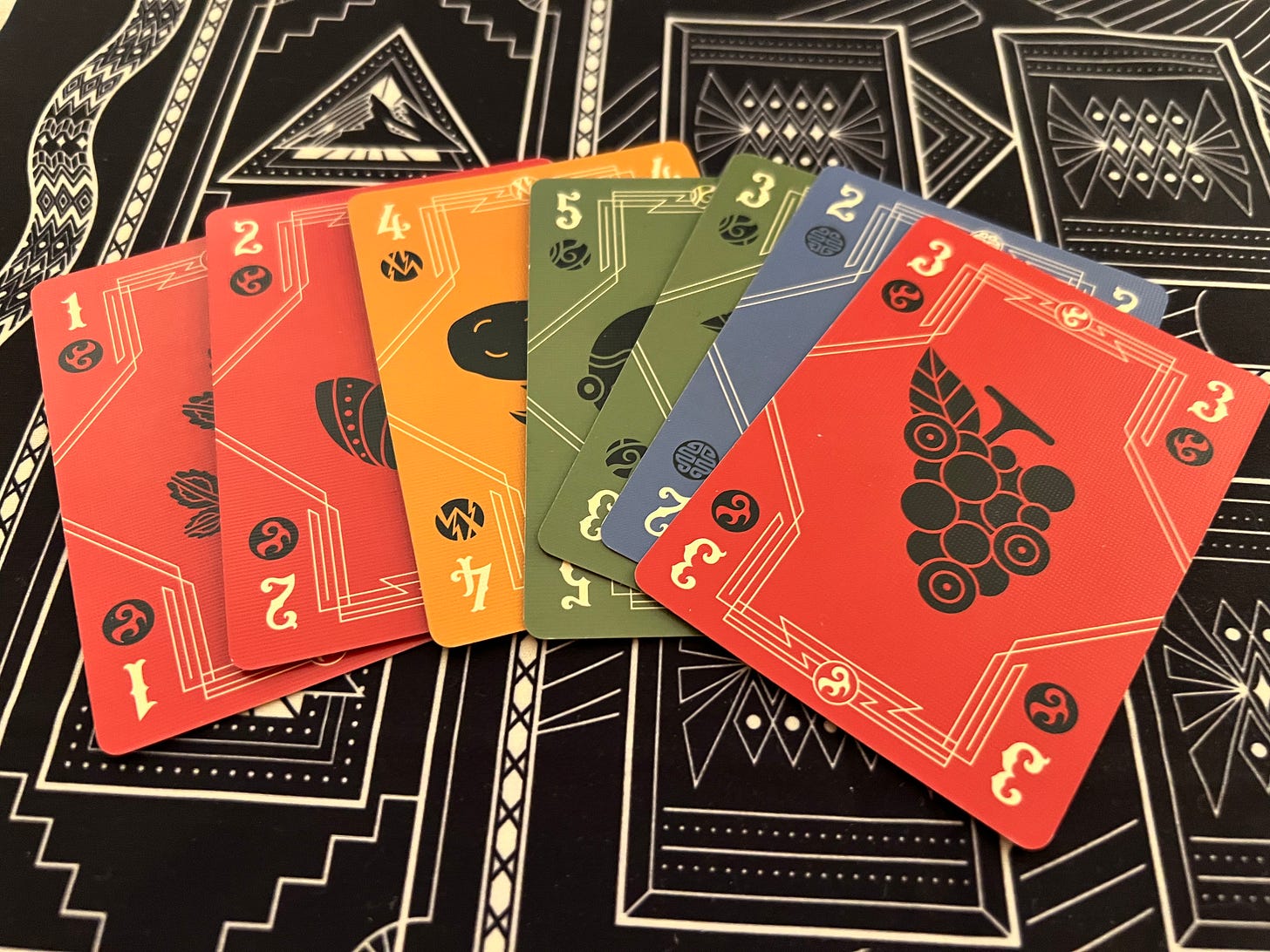On the Edge of Eternal (Decks)
A combinatorially complex game with a simple ruleset delivers a metal experience from start to finish
Opening a new game in front of other people is nerve wracking. The components are spread everywhere with little to no organization and you're just wondering if your companions are going to tap out before any of this gets started. For Eternal Decks that moment can feel overwhelming. There are roughly one million cards to pull apart and lots of different locations for various cards and components to go. The game mat is a sprawling but beautiful deep black and the cards have enticing and dynamic art.
There are various Eternals cards, their decks, your decks, the slots of each stage, the adventure cards, two rulebooks (there are actually four, an additional set in Japanese that I took out from my edition for my lack of ability to fluently read Japanese), the tokens, and your starter decks. All of them are beautiful, but the pieces alone are enough to overwhelm.
Luckily, once you get it set up it all falls into a predictable location and rhythm. There's really only one location on the board that you have to focus on, the center, and it's defined by only a couple of rules. You get started on your first game, a practice game of sorts. The rules are easy enough to follow. Turns are quick, play a card, draw a card. No duplicate adjacent colors or numbers, and then maybe ascending or descending. Try to complete a row. You've done it! The game shifts but you make your way through and, as a team, you win!
Congratulations you've managed to complete Stage A. There are 6 more!
Me and Cooperative Games
Eternal Decks is a cooperative game for two to for players (we played with four). It has all of the trappings of cooperative games. You can't communicate about the cards in your hand, you're trying to work together on a shared board against a shared goal. As the game progresses there are increasing opportunities and challenges. This feels like the right moment for me to say I typically hate co-op games. I find them quite boring and lifeless. There's no competitive tension in the game because there are only inefficiencies of other players not playing optimally.
Eternal Decks is nothing like that. There are some games with few rules that are incredibly complex, other games with many rules that are incredibly simple, and other games that seem complex but are shockingly easy to operate. This is the latter. Eternal Decks is combinatorially complex enough that each individual player has a lot of leeway in how they want to play their turn. But conceptually it's easy enough to understand that the team can easily build a general strategy together.
Most cooperative games start out slow, with players groping to figure out the optimal move without much feedback, pick up the pace, and then also end slow when the end result is all too obvious, and you find yourself walking through the motions.
Eternal Decks is way too metal for that. It starts with your backs against the wall, scrambling to find a foothold, and it ends with your backs once again at the wall trying to complete the objective in just the nick of time.
The Rules
The game is a cooperative deckbuilding/card shedding game. You are trying, as a group to lay out rows of cards following a given rule, like play in ascending or descending order. Once you lay out the correct number of cards, the player who last played gets a fresh deck (corresponding with the Eternal that's been defeated).
The catch? If at any point a player can’t take their turn, you all lose. There’s no creeping sense of defeat or slow march that other coop games feature. The abrupt cutoff means you’re always on edge. The start of each game feels like a race against death. You each only have 5 cards and you're trying to chart a path to get each team member their first deck (first real deck anyway) without sacrificing too much. As the game evolves towards the conclusion you will once again find yourself with relatively few cards, more restrictions and desperately trying to find a way to win before time runs out.
The Eternal Decks (the namesake) is one of the most interesting and exciting part of the game. Each Eternal has a bonus (the deck the player unlocks when they defeat it) and a challenge (the cards they shut down). This means that picking the eternal is as much about balancing positives and negatives. There’s none of that deck building optimization explosion at the end where you can do everything all at once. Instead the endings to games feel like a mad dash. Eking out the final points for victory as the last cards in your deck slip away.
The deck will open up new options and the curse will make specific restrictions about cards that the entire group cannot play while that Eternal is active. You can deactivate the Eternal for a cost of your cards. This is challenging because your cards are your life and spending them on anything other than meeting your goals or making progress towards collecting a new deck is painful, visceral almost.
The Experience
This feels like one of those games that learned from the legacy experiences without needing to fully recreate one. You play over seven stages, with each stage introducing a new twist or concept. You can replay each stage as much as you want. We ended up playing through 4 stages (losing on the last one) and are eager to pick the game back up.
You're not destroying cards or adding stickers or creating a "unique" play experience. What you are doing is layering on and varying concepts so each set of goals as you move through stages gets harder and more interesting. I don't want to spoil too much here but there's a delightful variety of puzzles, enemies, and adventuring, in a way that feels almost video game like.
This games feels maximalist in a really great way. The surplus of components gives way to a simple core idea that the creator is playing around with, and you get to experience all of it. There are so many different components and ideas flowing around, but they way they get presented made them easy to understand and reason about. There were never moments where we forgot what to do. While we had a couple of rulebook questions for the most part the rulebook just confirmed what we already intuitively assumed about the game.
Card games are all about the fun of reacting to new information and watching a board state develop as things change. The relationship between the values of the cards, their position on the board, and when you happen to draw them is a core conceit of the game. So it has a real card game aesthetic. You're not just using cards as an abstract representation of something else.
Should You Play?
If you have time/energy to dedicate and can get your hands on a copy, I would absolutely recommend it. It's a really impressive game where a design with big ideas feels approachable to people who don't play a ton of games while having the sort of novelty and hooks that draw in people who've played a ton.
The One Downside.
The one downside to this game is that it just cannot be called colorblind friendly in the slightest. Not only are the colors not combined with patterns or other markers, there are so many extra symbols that it would be confusing even if they did.
I found myself confused why the various colors couldn't have symbols assigned to them. I realize it would've reduced flavor minorly, but it would've helped from an accessibility perspective, and also added clarity to the functionality of cards. For example, there were times when people asked if "all purples are special or just the ones that you can purchase?" The rules never really differentiated, but having them be a different symbol only added to the confusion. Consistency would've been a big help here.
Rejuvenating Games
I absolutely recommend this game. It's a real gem. It's the type of game that makes you want to try designing games for yourself and excited to try playing again to go deeper.




